We guide you to the optimum laser system
A fast response time and 10 years of comprehensive after-sales support enable you to ensure long-term reliable operation.
We represent international manufacturers of a wide range of laser types in order to offer you the optimum solution.
Nano to Femto
cw
Fixed wavelength
& tunable
from 216 nm
up to 18 µm
µJ - 10 J
mW - 100W
Our plan
We analyze your individual requirements, processes and operating conditions in detail.
We test various laser types and manufacturers for their suitability and compare them objectively in terms of technology and cost-effectiveness.
You will receive a specific recommendation with comprehensible reasons - for a solution that suits your needs.
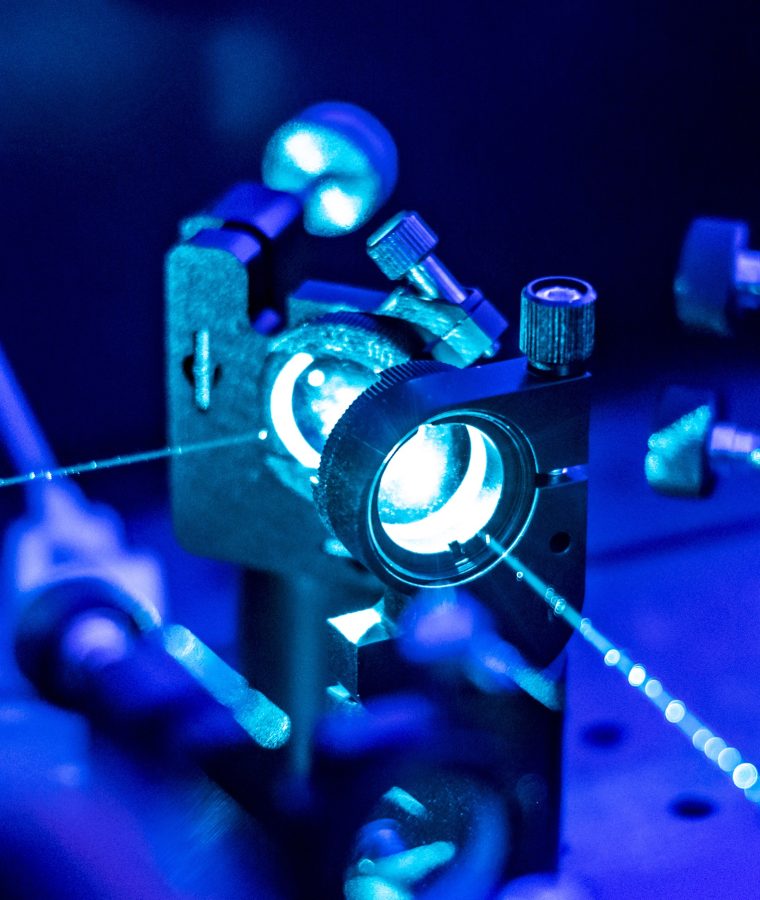
Your application - Our solution
Micro material processing
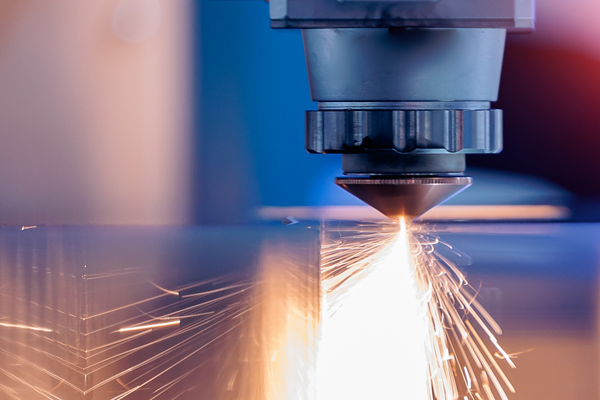
When precision is required
Micromaterial processing with lasers enables the high-precision processing of a wide variety of materials such as glass, metals, semiconductors or polymers – often where conventional processes reach their limits. Different laser wavelengths and pulse lengths allow targeted adaptation to the respective material properties.
- Resolution less than 10µm
- Drilling – Cutting – Removing – Structuring
- Minimization of thermal load
- High reproducibility
The right lasers for you
FemtoLux | Ekspla
50W industrial fs laser, with GHz & PoD
- Wavelength: 1030nm, up to TH
- Pulse energy: max. 100µJ, 50W
- Repetition rate: max. 4MHz
- Pulse duration: <350fs – 1ps
FemtoLux3 | Ekspla
3W industrial fs laser
- Wavelength: 1030nm, up to SH
- Pulse energy: max. 3µJ, 3W
- Repetition rate: max. 10MHz
- Pulse duration: 300fs – 5ps
Atlantic | Ekspla
Industrial picosecond laser
- Wavelength: 1064nm, up to TH
- Pulse energy: max. 200µJ, 80W
- Repetition rate: max. 1MHz
- Pulse duration: <10ps
NL200 | Ekspla
DPSS, compact, active Q-Switch
- Wavelength: 1064nm, up to FiH
- Pulse energy: max. 4mJ
- Repetition rate: max. 2500Hz
- Pulse duration: 7-10ns
UltraTune 3400 | Femtum
Industrial MIR infrared fs laser
- Wavelength: 3 – 3.4µm
- Pulse energy: max. 17nJ, 500mW
- Repetition rate: max. 50MHz
- Pulse duration: <500fs
GSL | QS Lasers
Gain switch, DPSS, air-cooled,
- Wavelength: 1064nm
- Pulse energy: max. 2mJ
- Repetition rate: max. 100Hz
- Pulse duration: 60 / 100ps
Wafer Laser Trimming
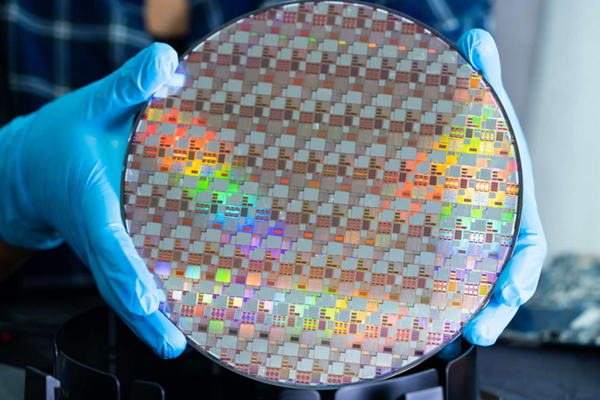
Fine adjustment by laser beam
Wafer laser trimming is a specialized technology for photonics and semiconductor production. Precise laser ablation allows resistors in thin-film circuits and on integrated circuits, for example, to be set to the exact resistance value. The method enables high precision and reproducibility, even with complex structures. More details …
PIC Assembly Laser Cleaning
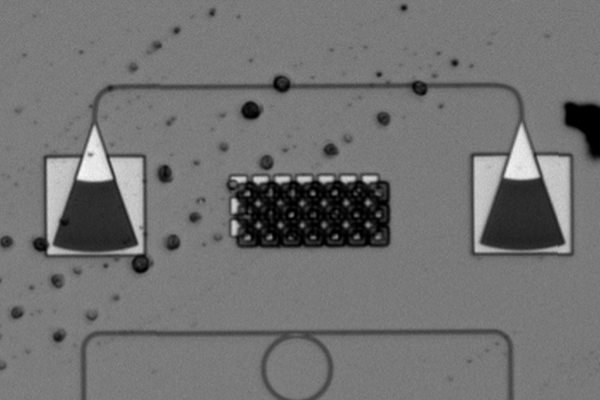
Dry, precise, contactless
Current cleaning methods such as ultrasonic baths do not always remove all residues, which can lead to a loss of quality. PIC Assembly laser cleaning at a wavelength of 3µm offers a precise, automated solution with less handling and thus reduces rejects in quality control – quick to integrate, efficient and gentle on the material. More details …
Quantum technologies
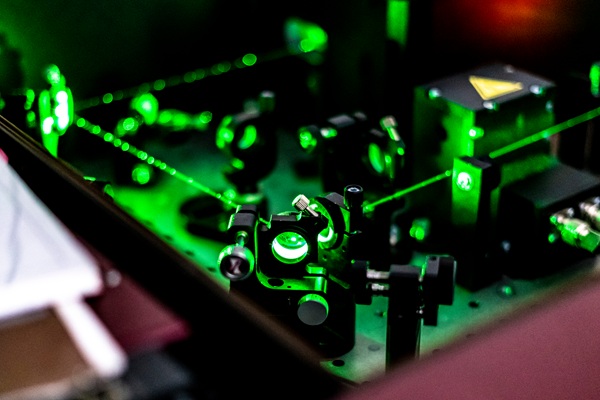
Interwoven reality
Pulsed lasers enable the targeted excitation and control of quantum systems such as atoms, ions or photons. They are used in quantum communication, quantum sensor technology and in the generation and manipulation of individual qubits with maximum temporal precision.
The right lasers for you
Peaches | Irisiome Solutions
For quantum technologies
- Wavelength: 460 – 1560nm
- Pulse energy: >1µJ, 30W
- Repetition rate: max. 2GHz
- Pulse duration: 500fs – 35ps
Q2 | QLI
DPSS, active Q-Switch, air-cooled
- Wavelength: 1064nm, up to FiH
- Pulse energy: max. 80mJ
- Repetition rate: max. 100Hz
- Pulse duration: <5-10ns
Photo-acoustic imaging
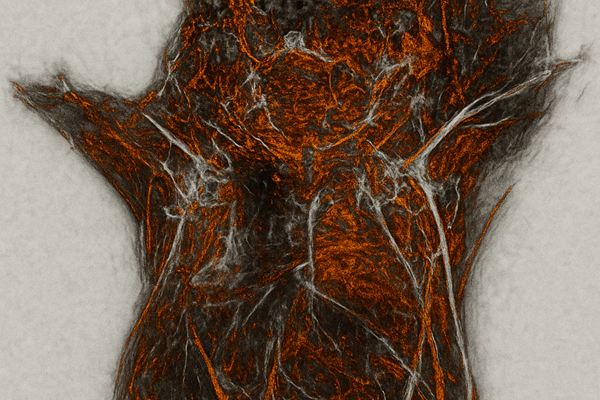
Hearing with light - seeing with sound
Laser-based photoacoustic imaging is an innovative method that combines light and sound to generate high-resolution images of biological tissue. Tissue is irradiated with short, usually spectrally tunable laser pulses. These lead to minimal local heating and thus generate ultrasonic waves, which are measured and converted into images.
- Nano- and picosecond lasers
- Optimized absorption with tunable lasers
- Non-invasive method
- for cancer diagnostics, vascular and skin imaging
The right lasers for you
PhotoSonus M | Ekspla
Photo-acoustic, high energy, mobile
- Wavelength: 330-2300nm
- Pulse energy: max 250mJ
- Repetition rate: max 20Hz
- Pulse duration: 3-5ns
- Line width: < 10cm-1
PhotoSonus T | Ekspla
Photo-acoustics, high energy
- Wavelength: 330-2300nm
- Pulse energy: max 230mJ
- Repetition rate: max 20Hz
- Pulse duration: 3-5ns
- Line width: < 10cm-1
PhotoSonus X | Ekspla
Photo-acoustic, higher repeating
- Wavelength: 650-2600nm
- Pulse energy: max 90mJ
- Repetition rate: max 100Hz
- Pulse duration: 2-5ns
- Line width: 10cm-1
NT240 | Ekspla
UV-NIR, high-repetition, DPSS
- Wavelength: 210-2600nm
- Pulse energy: max 450µJ
- Repetition rate: 1000Hz
- Pulse duration: 3-6ns
- Line width: < 5cm-1
NT260 | Ekspla
UV-NIR, high-repetition, DPSS
- Wavelength: 210-2600nm
- Pulse energy: max 450µJ
- Repetition rate: 10kHz
- Pulse duration: 7ns
- Line width: < 5cm-1
Q-Tune | QLI
UV-NIR, DPSS, air-cooled
- Wavelength: 210-2300nm
- Pulse energy: max 8mJ
- Repetition rate: max 100Hz
- Pulse duration: 2-5ns
- Line width: < 6cm-1
Q-Tune-G | QLI
VIS-NIR, DPSS, air-cooled
- Wavelength: 680-2300nm
- Pulse energy: max 11mJ
- Repetition rate: max 100Hz
- Pulse duration: <4ns
- Line width: < 10-15cm-1 or ~100cm-1
Q-Tune-HR | QLI
High-repetition, NIR-MIR, DPSS
- Wavelength: 750-1800nm / 1600-3200nm
- Pulse energy: max 100µJ
- Repetition rate: max 100kHz
- Pulse duration: 5-7ns
- Line width: 20-100cm-1
PT403 | Ekspla
Picoseconds, UV-IR, DPSS
- Wavelength: 210-2300nm
- Pulse energy: max >75µJ
- Repetition rate: max 1kHz
- Pulse duration: 20ps
- Line width: < 9cm-1
Pump-probe spectroscopy
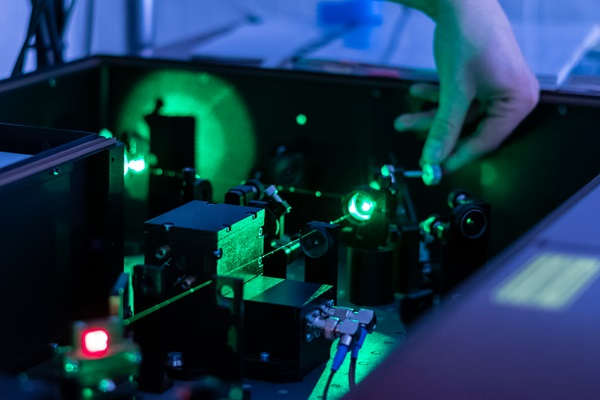
Pumps. Samples. Understanding
Pump-probe spectroscopy provides insight into ultrafast processes at the atomic and molecular level. Pulsed lasers can be used to track dynamic changes with high temporal resolution. Applications include the investigation of charge carrier dynamics in semiconductors, electron transfer in chemical reactions and light-induced phase transitions in materials.
- Time resolution down to the femtosecond range
- Pulse energies up to the joule range
- Optimized processes with tunable lasers
- Stable synchronization
The right lasers for you
PL2210 | Ekspla
Picosecond, DPSS, low-jitter, air-cooled
- Wavelength: 1064nm, up to FH
- Pulse energy: max. 5mJ
- Repetition rate: 1kHz
- Pulse duration: 29ps
PL2230 | Ekspla
picosecond, high energy, DPSS, low jitter
- Wavelength: 1064nm, up to FiH
- Pulse energy: max. 40mJ
- Repetition rate: max. 100Hz
- Pulse duration: 29ps
PL2250 | Ekspla
Picosecond, high energy, low jitter
- Wavelength: 1064nm, up to FiH
- Pulse energy: max. 100mJ
- Repetition rate: max. 20Hz
- Pulse duration: 29ps
NT230 | Ekspla
Tunable, ns, high energy, DUV-NIR, DPSS
- Wavelength: 192-2600nm
- Pulse energy: max. 15mJ
- Repetition rate: max. 100Hz
- Pulse duration: 2-5ns
- Line width: < 5cm-1
NT240 | Ekspla
Tunable, ns, UV-NIR, high-repetition, DPSS
- Wavelength: 210-2600nm
- Pulse energy: max. 450µJ
- Repetition rate: 1000Hz
- Pulse duration: 3-6ns
- Line width: < 5cm-1
NT250 | Ekspla
Tunable, ns, high energy/repeating
- Wavelength: 335-2600nm
- Pulse energy: max. 1100µJ
- Repetition rate: 1000Hz
- Pulse duration: 1-4ns
- Line width: < 5cm-1
NT260 | Ekspla
Tunable, ns, UV-NIR, high-repetition, DPSS
- Wavelength: 210-2600nm
- Pulse energy: max. 450µJ
- Repetition rate: 10kHz
- Pulse duration: 7ns
- Line width: < 5cm-1
NT340 | Ekspla
Tunable, ns, DUV-MIR, high energy
- Wavelength: 192-4400nm
- Pulse energy: max. 90mJ
- Repetition rate: max. 20Hz
- Pulse duration: 3-5ns
- Line width: < 5cm-1
PT403 | Ekspla
Tunable, ps, UV-NIR, DPSS
- Wavelength: 210-2300nm
- Pulse energy: max. 75µJ
- Repetition rate: max. 1kHz
- Pulse duration: 20ps
- Line width: < 9cm-1
PT501 | Ekspla
Tunable, ps, NIR-MIR, higher energy
- Wavelength: 2300-16000nm
- Pulse energy: >200µJ
- Repetition rate: 100Hz
- Pulse duration: 20ps
- Line width: < 4cm-1
Laser-induced plasma spectroscopy (LIBS)
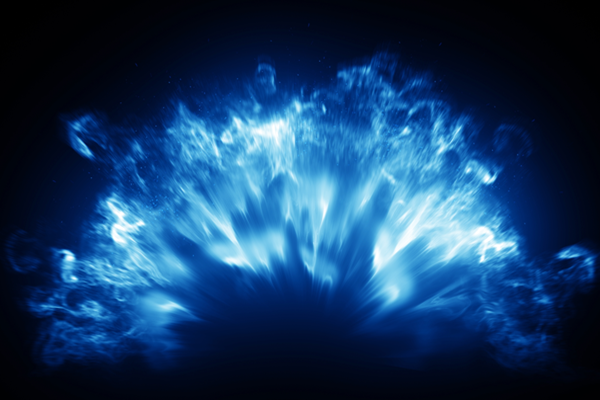
Destruction for precise findings
Laser-induced plasma spectroscopy (LIBS) is a fast, almost non-destructive method for determining the composition of elements. A laser pulse generates a plasma on the sample, the characteristic emission of which is analyzed. LIBS is suitable for almost all materials – solid, liquid or gaseous – and provides fast, spatially resolved or mobile analysis.
- Pulse energies up to 10J, pulse durations: ns and ps
- Repetition rate in the Hz-kHz range
- Robust and compact design
- Fast element analysis
The right lasers for you
Q2 | QLI
Nanosecond, DPSS, air-cooled
- Wavelength: 1064nm, up to FiH
- Pulse energy: max. 80mJ
- Repetition rate: max. 100Hz
- Pulse duration: <5-10ns
Q-Spark | QLI
Nanosecond, DPSS, short pulses, air-cooled
- Wavelength: 1064nm, up to FH
- Pulse energy: max. 20mJ
- Repetition rate: max. 100Hz
- Pulse duration: 750ps – 2ns
NL230 | Ekspla
Nanosecond, High energy, DPSS
- Wavelength: 1064nm, up to FH
- Pulse energy: max. 190mJ
- Repetition rate: max. 100Hz
- Pulse duration: 3-6ns
NL300 | Ekspla
Nanosecond, compact, flashlamp-pumped
- Wavelength: 1064nm, up to FiH
- Pulse energy: max. 1100mJ
- Repetition rate: max. 20Hz
- Pulse duration: 3-6ns
NanoFlux MM | Ekspla
Nanosecond, very high pulse energy
- Wavelength: 1064nm, up to FH
- Pulse energy: max. 10J
- Repetition rate: 10Hz
- Pulse duration: 5ns
NanoFlux HP | Ekspla
Nanosecond, high pulse energy & rep. rate
- Wavelength: 1064nm, up to TH
- Pulse energy: up to 2J (200W)
- Repetition rate: up to 1kHz
- Pulse duration: 5ns
MPL passive | QS Lasers
Sub-nanosecond, DPSS, passive Q-switch
- Wavelength: 1064nm, up to TH
- Pulse energy: max. 1.5mJ
- Repetition rate: 1-100Hz
- Pulse duration: <250ps | <500ps
APL active | QS Lasers
Sub-nanosecond, DPSS, active Q-switch
- Wavelength: 1064nm, up to TH
- Pulse energy: max. 2mJ
- Repetition rate: 1-1000Hz
- Pulse duration: <700ps
GSL | QS Lasers
Sub-nanosecond, DPSS, gain switch
- Wavelength: 1064nm
- Pulse energy: max. 2mJ
- Repetition rate: max. 100Hz
- Pulse duration: 60 / 100ps
PL2230 | Ekspla
picosecond, high energy, DPSS, low jitter
- Wavelength: 1064nm, up to FiH
- Pulse energy: max. 40mJ
- Repetition rate: max. 100Hz
- Pulse duration: 29ps
PL2250 | Ekspla
Picosecond, high energy, low jitter
- Wavelength: 1064nm, up to FiH
- Pulse energy: max. 100mJ
- Repetition rate: max. 20Hz
- Pulse duration: 29ps
Photoluminescence spectroscopy
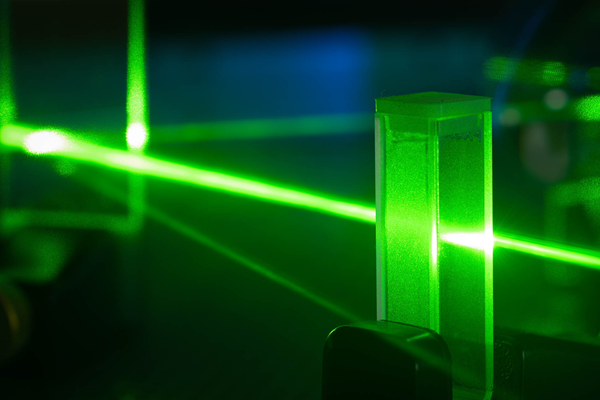
Emission that provides insights
Photoluminescence spectroscopy (PL) is a non-contact method for investigating the electronic and structural properties of materials. The material is excited by light and the emitted radiation is analyzed. This provides information about band gaps, defects, doping or quantum structure in semiconductors, nanostructures and optoelectronic materials.
- Nano- and picosecond lasers
- Optimized analysis with tunable lasers
- Narrow-band lasers for resonant excitation
- High sensitivity for electronic states
The right lasers for you
NT230 | Ekspla
Tunable, ns, high energy, DUV-NIR, DPSS
- Wavelength: 192-2600nm
- Pulse energy: max. 15mJ
- Repetition rate: max. 100Hz
- Pulse duration: 2-5ns
- Line width: < 5cm-1
NT240 | Ekspla
Tunable, ns, UV-NIR, high-repetition, DPSS
- Wavelength: 210-2600nm
- Pulse energy: max. 450µJ
- Repetition rate: 1000Hz
- Pulse duration: 3-6ns
- Line width: < 5cm-1
NT260 | Ekspla
Tunable, ns, UV-NIR, high-repetition, DPSS
- Wavelength: 210-2600nm
- Pulse energy: max. 450µJ
- Repetition rate: 10kHz
- Pulse duration: 7ns
- Line width: < 5cm-1
NT340 | Ekspla
Tunable, ns, DUV-MIR, high energy
- Wavelength: 192-4400nm
- Pulse energy: max. 90mJ
- Repetition rate: max. 20Hz
- Pulse duration: 3-5ns
- Line width: < 5cm-1
PL2230 | Ekspla
picosecond, high energy, DPSS, low jitter
- Wavelength: 1064nm, up to FiH
- Pulse energy: max. 40mJ
- Repetition rate: max. 100Hz
- Pulse duration: 29ps
PL2250 | Ekspla
Picosecond, high energy, low jitter
- Wavelength: 1064nm, up to FiH
- Pulse energy: max. 100mJ
- Repetition rate: max. 20Hz
- Pulse duration: 29ps
PGx01 | Ekspla
Picosecond, High energy, DUV-MIR
- Wavelength: 192-16000nm
- Pulse energy: max. 1mJ
- Repetition rate: up to 50Hz
- Pulse duration: up to 20ps
- Line width: < 6cm-1
Particle Image Velocimetry (PIV)
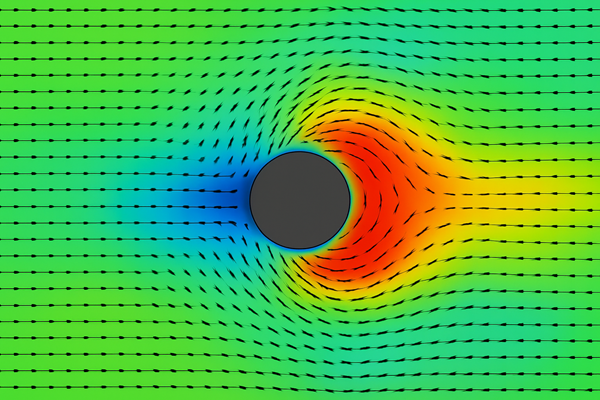
Making currents visible
Particle Image Velocimetry (PIV) is an optical method for determining flow velocities in liquids or gases. Fine particles in the medium are illuminated with two laser pulses in quick succession, recording their movement. The direction and speed of the flow can be precisely calculated from the offset between the images.
- High pulse energy
- Very low jitter
- High pulse-to-pulse stability
- Air-cooled, compact design
The right laser for you
Q-Double | QLI
Double-pulse laser for PIV
- Wavelength: 1064nm, up to FH
- Pulse energy: up to 80mJ
- Repetition rate: max 100Hz
- Pulse duration: <7ns
LIDAR - Light Detection and Ranging
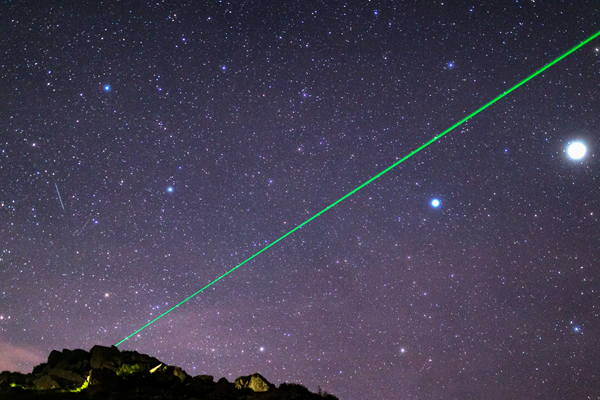
Distance as a data source
LIDAR emits short laser pulses that are scattered by particles, aerosols or molecules in the atmosphere and detected by a telescope. The distance is calculated from the light travel time – creating a spatial profile along the beam. LIDAR uses UV, visible or near-infrared light and is suitable for detecting a wide variety of materials.
- High pulse stability
- Good beam quality
- Nano- and picosecond lasers
- Robust and compact design
The right lasers for you
NL230 | Ekspla
Nanosecond, High energy, DPSS
- Wavelength: 1064nm, up to FH
- Pulse energy: max. 190mJ
- Repetition rate: max. 100Hz
- Pulse duration: 3-6ns
NL300 | Ekspla
Nanosecond, compact, flashlamp-pumped
- Wavelength: 1064nm, up to FiH
- Pulse energy: max. 1100mJ
- Repetition rate: max. 20Hz
- Pulse duration: 3-6ns
NanoFlux MM | Ekspla
Nanosecond, very high pulse energy
- Wavelength: 1064nm, up to FH
- Pulse energy: max. 10J
- Repetition rate: 10Hz
- Pulse duration: 5ns
NanoFlux HP | Ekspla
Nanosecond, high pulse energy & rep. rate
- Wavelength: 1064nm, up to TH
- Pulse energy: up to 2J (200W)
- Repetition rate: up to 1kHz
- Pulse duration: 5ns
NT230 | Ekspla
Tunable, ns, high energy, DUV-NIR, DPSS
- Wavelength: 192-2600nm
- Pulse energy: max. 15mJ
- Repetition rate: max. 100Hz
- Pulse duration: 2-5ns
- Line width: < 5cm-1
NT250 | Ekspla
Tunable, ns, high energy/repeating
- Wavelength: 335-2600nm
- Pulse energy: max. 1100µJ
- Repetition rate: 1000Hz
- Pulse duration: 1-4ns
- Line width: < 5cm-1
NT340 | Ekspla
Tunable, ns, DUV-MIR, high energy
- Wavelength: 192-4400nm
- Pulse energy: max. 90mJ
- Repetition rate: max. 20Hz
- Pulse duration: 3-5ns
- Line width: < 5cm-1
PL2230 | Ekspla
picosecond, high energy, DPSS, low jitter
- Wavelength: 1064nm, up to FiH
- Pulse energy: max. 40mJ
- Repetition rate: max. 100Hz
- Pulse duration: 29ps
PL2250 | Ekspla
Picosecond, high energy, low jitter
- Wavelength: 1064nm, up to FiH
- Pulse energy: max. 100mJ
- Repetition rate: max. 20Hz
- Pulse duration: 29ps
PicoFlux HE | Ekspla
High pulse energy, flashlamp-pumped
- Wavelength: 1064nm, up to FH
- Pulse energy: max 2.2J
- Repetition rate: 10Hz
- Pulse duration: 90ps
PicoFlux HP| Ekspla
High repetition rate, diode-pumped
- Wavelength: 1064nm, up to FH
- Pulse energy: 130W or 500mJ
- Repetition rate: up to 1000Hz
- Pulse duration: 90ps
SFG spectroscopy
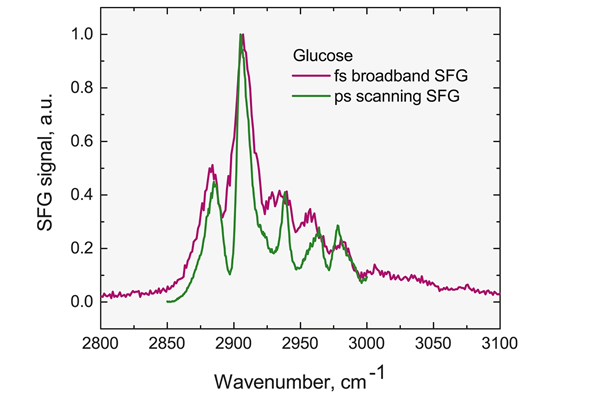
The sum makes the difference
SFG spectroscopy (Sum-Frequency Generation) is a non-linear optical method for investigating molecules at surfaces and interfaces (e.g. solid-liquid). A visible and an IR laser generate a sum frequency signal that only occurs at non-centrosymmetric structures. By tuning to molecular vibrations, SFG provides selective, spectrally high-resolution information.
- Complete systems incl. laser and analysis system
- Narrowband and broadband systems
- with pico- or femtosecond pulses
- VIS: 532nm, tunable IR laser: 2.5-18 µm
The right lasers for you
ps-SFG Spectrometer | Ekspla
Narrow-band excitation of individual bands
- Measuring spectrum: 667 – 4300 cm-1
- Spectral resolution: up to < 5cm-1
- Measurement: Scanning, PMT
- Low influence IR absorption in air
fs-SFG Spectrometer | Ekspla
Excitation of a broad vibration spectrum
- Measuring spectrum: 1000 – 4300 cm-1
- Spectral resolution: up to < 5cm-1
- Measurement: broadband accumulation, CCD
- Biological samples containing water
Plasma physics
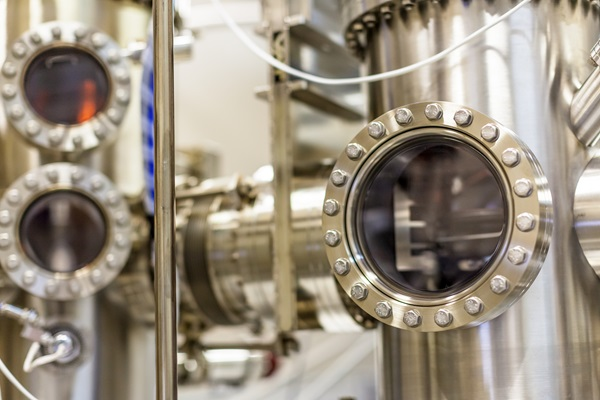
Analysis of ionized matter
High-energy laser pulses generate plasmas for a wide range of applications such as elemental analysis (LIBS), thin film deposition (PLD), explosives detection, environmental analysis and planetary exploration. Advances in short-pulse technology also enable compact EUV and X-ray sources for lithography, material diagnostics and time-resolved experiments.
- High contrast ratio
- Short pulse duration up to <20ps
- Time-formed impulses
- High energy stability
The right lasers for you
NL300 | Ekspla
Nanosecond, compact, flashlamp-pumped
- Wavelength: 1064nm, up to FiH
- Pulse energy: max. 1100mJ
- Repetition rate: max. 20Hz
- Pulse duration: 3-6ns
NanoFlux MM | Ekspla
Nanosecond, very high pulse energy
- Wavelength: 1064nm, up to FH
- Pulse energy: max 10J
- Repetition rate: 10Hz
- Pulse duration: 5ns
- Line width: < 1cm-1
NanoFlux HP | Ekspla
Nanosecond, high pulse energy & rep. rate
- Wavelength: 1064nm, up to TH
- Pulse energy: up to 2J (200W)
- Repetition rate: up to 1kHz
- Pulse duration: 5ns
PL2230 | Ekspla
picosecond, high energy, DPSS, low jitter
- Wavelength: 1064nm, up to FiH
- Pulse energy: max. 40mJ
- Repetition rate: max. 100Hz
- Pulse duration: 29ps
PL2250 | Ekspla
Picosecond, high energy, low jitter
- Wavelength: 1064nm, up to FiH
- Pulse energy: max. 100mJ
- Repetition rate: max. 20Hz
- Pulse duration: 29ps
PicoFlux HE | Ekspla
Picosecond, high pulse energy
- Wavelength: 1064nm, up to FH
- Pulse energy: max 2.2J
- Repetition rate: 10Hz
- Pulse duration: 90ps
PicoFlux HP| Ekspla
Picosecond, High Pulse Energy & Rep Rate
- Wavelength: 1064nm, up to FH
- Pulse energy: 130W or 500mJ
- Repetition rate: up to 1000Hz
- Pulse duration: 90ps
Ultra-high intensities
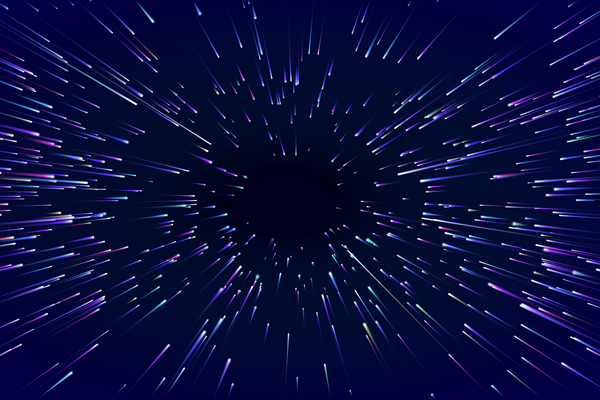
Extreme fields - extreme effects
Lasers with ultra-high intensity (≥ 10¹⁸ W/cm²) open up new physical regimes. Relativistic effects allow the acceleration of electrons, the generation of hard radiation (X-rays, γ) and ion sources. Applications can be found in particle acceleration, laser-driven fusion, laboratory astrophysics and high-field quantum optics.
- High contrast ratio
- Short pulse duration up to <8fs
- Pulse energy up to 14J
- Stable synchronization
The right lasers for you
NanoFlux MM | Ekspla
Nanosecond, very high pulse energy
- Wavelength: 1064nm, up to FH
- Pulse energy: max 10J
- Repetition rate: 10Hz
- Pulse duration: 5ns
- Line width: < 1cm-1
NanoFlux HP | Ekspla
Nanosecond, high pulse energy & rep. rate
- Wavelength: 1064nm, up to TH
- Pulse energy: up to 2J (200W)
- Repetition rate: up to 1kHz
- Pulse duration: 5ns
NanoFlux SLM | Ekspla
High pulse energy, single mode
- Wavelength: 1064nm, up to FH
- Pulse energy: up to 10J
- Repetition rate: 10Hz
- Pulse duration: 2ns
- Line width: <0.01cm-1 (SLM)
NanoFlux AWG | Ekspla
Temporal pulse shaping, flashlamp-pumped
- Wavelength: 1064nm, up to TH
- Pulse energy: max 10J
- Repetition rate: 10Hz
- Pulse duration: moldable 0.15-500ns
PicoFlux HE | Ekspla
Picosecond, high pulse energy
- Wavelength: 1064nm, up to FH
- Pulse energy: max 2.2J
- Repetition rate: 10Hz
- Pulse duration: 90ps
PicoFlux HP| Ekspla
Picosecond, High Pulse Energy & Rep Rate
- Wavelength: 1064nm, up to FH
- Pulse energy: 130W or 500mJ
- Repetition rate: up to 1000Hz
- Pulse duration: 90ps
PicoFlux Custom | Ekspla
Picosecond, Multi-Channel
- Wavelength: 1064nm, up to FH
- Pulse energy: up to 14J
- Repetition rate: up to 10kHz
- Pulse duration: 90ps to 1 ps
UltraFlux HE | Ekspla
Femtosecond, tunable, high pulse energy
- Wavelength: 750-960nm tunable, up to FH
- Pulse energy: up to 800mJ
- Repetition rate: up to 100Hz
- Pulse duration: <10fs
UltraFlux HR | Ekspla
Femtosecond, tunable, High rep rate
- Wavelength: 750-960nm tunable, up to FH
- Pulse energy: up to 14mJ
- Repetition rate: 1kHz
- Pulse duration: <40fs
UltraFlux Custom | Ekspla
Multi TW OPCPA, Fundamental Research
- Wavelength: 900nm
- Pulse energy: 120mJ, 15TW peak power
- Repetition rate: up to 1kHz
- Pulse duration: <8fs
Manufacturer overview





Overview of the different laser categories
Femtosecond laser
FemtoLux | Ekspla
industrial fs laser, with GHz & PoD
- Wavelength: 1030nm, up to TH
- Pulse energy: max. 100µJ, 50W
- Repetition rate: max. 4MHz
- Pulse duration: <350fs – 1ps
FemtoLux3 | Ekspla
3W industrial fs laser
- Wavelength: 1030nm, up to SH
- Pulse energy: max. 3µJ, 3W
- Repetition rate: max. 10MHz
- Pulse duration: 300fs – 5ps
LightWire FFS | Ekspla
Compact fs fiber seeder
- Wavelength: 1030, 1064nm
- Pulse energy: max. 250nJ, 0.2W
- Repetition rate: 40MHz / 50MHz
- Pulse duration: <130fs, 50ps chirped
UltraTune 3400 | Femtum
Industrial MIR infrared fs laser
- Wavelength: 3 – 3.4µm
- Pulse energy: max. 17nJ, 500mW
- Repetition rate: max. 50MHz
- Pulse duration: <500fs
Picosecond laser
PL2210 | Ekspla
DPSS, low-jitter, air-cooled
- Wavelength: 1064nm, up to FH
- Pulse energy: max. 5mJ
- Repetition rate: 1kHz
- Pulse duration: 29ps
PL2230 | Ekspla
High energy, DPSS, low jitter
- Wavelength: 1064nm, up to FiH
- Pulse energy: max. 40mJ
- Repetition rate: max. 100Hz
- Pulse duration: 29ps
PL2250 | Ekspla
High energy, flash lamp, low jitter
- Wavelength: 1064nm, up to FiH
- Pulse energy: max. 100mJ
- Repetition rate: max. 20Hz
- Pulse duration: 29ps
Atlantic | Ekspla
Industrial picosecond laser
- Wavelength: 1064nm, up to TH
- Pulse energy: max. 200µJ, 80W
- Repetition rate: max. 1MHz
- Pulse duration: <10ps
LightWire FPS | Ekspla
Compact ps fiber seeder
- Wavelength: 1064nm
- Pulse energy: max. 50nJ, 200mW
- Repetition rate: max. 50MHz
- Pulse duration: 7(10)ps
Diego | Irisiome Solutions
DPSS, air-cooled, flexible
- Wavelength: 1030 – 1560nm
- Pulse energy: >1µJ, 30W
- Repetition rate: 10 – 100 MHz
- Pulse duration: 350fs – 20ps
Peaches | Irisiome Solutions
For quantum technologies
- Wavelength: 460 – 1560nm
- Pulse energy: >1µJ, 30W
- Repetition rate: max. 2GHz
- Pulse duration: 500fs – 35ps
Manny-IR | Irisiome Solutions
DPSS, air-cooled, flexible
- Wavelength: 1030 – 1560nm
- Pulse energy: >1µJ, 30W
- Repetition rate: max. 2GHz
- Pulse duration: 40ps – 1ns
Manny-VIS | Irisiome Solutions
DPSS, air-cooled, flexible
- Wavelength: 515 – 780nm
- Pulse energy: >1µJ, 10W
- Repetition rate: max. 2GHz
- Pulse duration: 35ps – 1ns
SID-IR | Irisiome Solutions
Compact, DPSS, air-cooled
- Wavelength: 1030 – 1560nm
- Pulse energy: >1µJ, 30W
- Repetition rate: max. 2GHz
- Pulse duration: 25ps
SID-VIS | Irisiome Solutions
Compact, DPSS, air-cooled
- Wavelength: 515 – 780nm
- Pulse energy: >1µJ, 10W
- Repetition rate: max. 2GHz
- Pulse duration: 25ps
GSL | QS Lasers
Gain switch, DPSS, air-cooled,
- Wavelength: 1064nm
- Pulse energy: max. 2mJ
- Repetition rate: max. 100Hz
- Pulse duration: 60 / 100ps
Sub-nanosecond laser
APL active | QS Lasers
DPSS, active Q-switch, low jitter
- Wavelength: 1064nm, up to TH
- Pulse energy: max. 2mJ
- Repetition rate: 1-1000Hz
- Pulse duration: <700ps
MPL passive | QS Lasers
DPSS, passive Q-switch, cost-efficient
- Wavelength: 1064nm, up to TH
- Pulse energy: max. 1.5mJ
- Repetition rate: 1-100Hz
- Pulse duration: <250ps | <500ps
Waveguard | Optogama
DPSS, passive Q-switch, air-cooled
- Wavelength: 1064nm or 532nm
- Pulse energy: ma.x 400µJ | 400mW
- Repetition rate: max. 10kHz
- Pulse duration: <1ns
Nanosecond laser
NL200 | Ekspla
DPSS, compact, active Q-Switch
- Wavelength: 1064nm, up to FiH
- Pulse energy: max. 4mJ
- Repetition rate: max. 2500Hz
- Pulse duration: 7-10ns
Q2 | QLI
DPSS, active Q-Switch, air-cooled
- Wavelength: 1064nm, up to FiH
- Pulse energy: max. 80mJ
- Repetition rate: max. 100Hz
- Pulse duration: <5-10ns
Q2HE | QLI
High-energy, DPSS, air-cooled
- Wavelength: 1064nm, up to FiH
- Pulse energy: max. 120mJ
- Repetition rate: max. 100Hz
- Pulse duration: <7ns
Nano 2800 | Femtum
Industrial MIR infrared ns laser
- Wavelength: 2.8µm
- Pulse energy: max. 3W, max. 100µJ
- Repetition rate: max. 30kHz
- Pulse duration: <200ns
More details …
Q1 | QLI
DPSS, active Q-Switch, air-cooled
- Wavelength: 1064nm, up to FiH
- Pulse energy: max. 40mJ
- Repetition rate: max. 50Hz
- Pulse duration: 7-10ns
Q-Spark | QLI
DPSS, short pulses, air-cooled
- Wavelength: 1064nm, up to FH
- Pulse energy: max. 20mJ
- Repetition rate: max. 100Hz
- Pulse duration: 750ps – 2ns
Q-Shift | QLI
Rare wavelengths
- Wavelength: 1163-1571nm (fixed), up to FH
- Pulse energy: max. 1W / 40mJ
- Repetition rate: max. 100Hz
- Pulse duration: 2-5ns
NL230 | Ekspla
High energy, DPSS, active Q-Switch
- Wavelength: 1064nm, up to FH
- Pulse energy: max. 190mJ
- Repetition rate: max. 100Hz
- Pulse duration: 3-6ns
NL300 | Ekspla
Compact, flashlamp-pumped
- Wavelength: 1064nm, up to FiH
- Pulse energy: max. 1100mJ
- Repetition rate: max. 20Hz
- Pulse duration: 3-6ns
Q-Double | QLI
Double-pulse laser for PIV
- Wavelength: 1064nm, up to FH
- Pulse energy: max. 80mJ
- Repetition rate: max. 100Hz
- Pulse duration: <7ns
Tunable femtosecond lasers
UltraTune 3400 | Femtum
Industrial MIR infrared fs laser
- Wavelength: 3 – 3.4µm
- Pulse energy: max. 17nJ, 500mW
- Repetition rate: max. 50MHz
- Pulse duration: <500fs
Tunable picosecond lasers
PT403 | Ekspla
Pump laser+OPG, UV-NIR, DPSS
- Wavelength: 210-2300nm
- Pulse energy: max >75µJ
- Repetition rate: max 1kHz
- Pulse duration: 20ps
- Line width: < 9cm-1
PT501 | Ekspla
Pump laser+OPG, NIR-MIR, higher energy
- Wavelength: 2300-16000nm
- Pulse energy: >200µJ
- Repetition rate: 100Hz
- Pulse duration: 20ps
- Line width: < 4cm-1
PT277 | Ekspla
MHz rate, UV-MIR, DPSS
- Wavelength: 1400-4400nm
- Pulse energy: 100mW
- Repetition rate: max 87MHz
- Pulse duration: 8ps
- Line width: < 5cm-1
PGx01 | Ekspla
High energy, DUV-MIR
- Wavelength: 192-16000nm
- Pulse energy: max 1mJ
- Repetition rate: up to 50Hz
- Pulse duration: up to 20ps
- Line width: < 6cm-1
Tunable nanosecond lasers
NT230 | Ekspla
High energy, DUV-NIR, DPSS
- Wavelength: 192-2600nm
- Pulse energy: max 15mJ
- Repetition rate: max 100Hz
- Pulse duration: 2-5ns
- Line width: < 5cm-1
NT240 | Ekspla
UV-NIR, high-repetition, DPSS
- Wavelength: 210-2600nm
- Pulse energy: max 450µJ
- Repetition rate: 1000Hz
- Pulse duration: 3-6ns
- Line width: < 5cm-1
NT250 | Ekspla
High energy/repeating, DPSS
- Wavelength: 335-2600nm
- Pulse energy: max 1100µJ
- Repetition rate: 1000Hz
- Pulse duration: 1-4ns
- Line width: < 5cm-1
NT260 | Ekspla
UV-NIR, high-repetition, DPSS
- Wavelength: 210-2600nm
- Pulse energy: max 450µJ
- Repetition rate: 10kHz
- Pulse duration: 7ns
- Line width: < 5cm-1
NT270 | Ekspla
NIR-MIR, high-repetition, DPSS
- Wavelength: 2500-4475nm
- Pulse energy: max 80µJ
- Repetition rate: 1000Hz
- Pulse duration: 5-7ns
- Line width: < 10cm-1
NT340 | Ekspla
DUV-MIR, high energy, flash lamps
- Wavelength: 192-4400nm
- Pulse energy: max 90mJ
- Repetition rate: max 20Hz
- Pulse duration: 3-5ns
- Line width: < 5cm-1
Q-Tune | QLI
UV-NIR, DPSS, air-cooled
- Wavelength: 210-2300nm
- Pulse energy: max 8mJ
- Repetition rate: max 100Hz
- Pulse duration: 2-5ns
- Line width: < 6cm-1
Q-Tune-G | QLI
VIS-NIR, DPSS, air-cooled
- Wavelength: 680-2300nm
- Pulse energy: max 11mJ
- Repetition rate: max 100Hz
- Pulse duration: <4ns
- Line width: < 10-15cm-1 or ~100cm-1
Q-Tune-IR | QLI
High energy, NIR-MIR, DPSS
- Wavelength: 1380-4500nm
- Pulse energy: max 17mJ
- Repetition rate: max 20Hz
- Pulse duration: 5-7ns
- Line width: < 10cm-1 or ~100cm-1
Q-Tune-HR | QLI
High-repetition, NIR-MIR, DPSS
- Wavelength: 750-1800nm / 1600-3200nm
- Pulse energy: max 100µJ
- Repetition rate: max 100kHz
- Pulse duration: 5-7ns
- Line width: 20-100cm-1
PhotoSonus M | Ekspla
Photo-acoustic, high energy, mobile
- Wavelength: 330-2300nm
- Pulse energy: max 250mJ
- Repetition rate: max 20Hz
- Pulse duration: 3-5ns
- Line width: < 10cm-1
PhotoSonus T | Ekspla
Photo-acoustics, high energy
- Wavelength: 330-2300nm
- Pulse energy: max 230mJ
- Repetition rate: max 20Hz
- Pulse duration: 3-5ns
- Line width: < 10cm-1
PhotoSonus X | Ekspla
Photo-acoustic, higher repeating
- Wavelength: 650-2600nm
- Pulse energy: max 90mJ
- Repetition rate: max 100Hz
- Pulse duration: 2-5ns
- Line width: 10cm-1
OPCPA systems
UltraFlux HE | Ekspla
High pulse energy, tunable
- Wavelength: 750-960nm tunable, up to FH
- Pulse energy: up to 800mJ
- Repetition rate: up to 100Hz
- Pulse duration: <10fs
UltraFlux HR | Ekspla
High repetition rate, tunable
- Wavelength: 750-960nm tunable, up to FH
- Pulse energy: up to 14mJ
- Repetition rate: 1kHz
- Pulse duration: <40fs
UltraFlux Custom | Ekspla
Multi TW OPCPA, Fundamental Research
- Wavelength: 900nm
- Pulse energy: 120mJ, 15TW peak power
- Repetition rate: up to 1kHz
- Pulse duration: <8fs
High power laser
PicoFlux HE | Ekspla
High pulse energy, flashlamp-pumped
- Wavelength: 1064nm, up to FH
- Pulse energy: max 2.2J
- Repetition rate: 10Hz
- Pulse duration: 90ps
PicoFlux HP| Ekspla
High repetition rate, diode-pumped
- Wavelength: 1064nm, up to FH
- Pulse energy: 130W or 500mJ
- Repetition rate: up to 1000Hz
- Pulse duration: 90ps
PicoFlux Custom | Ekspla
Multi-channel, picoseconds
- Wavelength: 1064nm, up to FH
- Pulse energy: up to 14J
- Repetition rate: up to 10kHz
- Pulse duration: 90ps to 1 ps
NanoFlux MM | Ekspla
High pulse energy, super-Gauss profile
- Wavelength: 1064nm, up to FH
- Pulse energy: max 10J
- Repetition rate: 10Hz
- Pulse duration: 5ns
- Line width: < 1cm-1
NanoFlux HP | Ekspla
High output, diode-pumped
- Wavelength: 1064nm, up to TH
- Pulse energy: up to 2J (200W)
- Repetition rate: up to 1kHz
- Pulse duration: 5ns
NanoFlux SLM | Ekspla
High pulse energy, single mode
- Wavelength: 1064nm, up to FH
- Pulse energy: up to 10J
- Repetition rate: 10Hz
- Pulse duration: 2ns
- Line width: <0.01cm-1 (SLM)
NanoFlux AWG | Ekspla
Temporal pulse shaping, flashlamp-pumped
- Wavelength: 1064nm, up to TH
- Pulse energy: max 10J
- Repetition rate: 10Hz
- Pulse duration: moldable 0.15-500ns
Laser diode modules
Dot diode laser modules
- Wavelength: 405 – 980nm
- Power: up to 400mW
- Options: Temperature stabilized (TEC) Computer control
Line diode laser modules
Different line lengths
- Wavelength: 405 – 980nm
- Power: up to 400mW
- Options: Temperature stabilized (TEC) Computer control
Cross-line diode laser modules
Different line lengths
- Wavelength: 405 – 980nm
- Power: up to 400mW
- Options: Temperature stabilized (TEC) Computer control
Multi-wavelength modules
2- 3 wavelengths simultaneously
- Wavelength: 405 – 780nm
- Power: up to 100mW
- Computer control, high stability Touch screen
Customized solutions
Adapted and optimized, among other things:
- Wavelengths / Electronics
- mechanical design
- Driver with firmware and software
- Fiber coupling